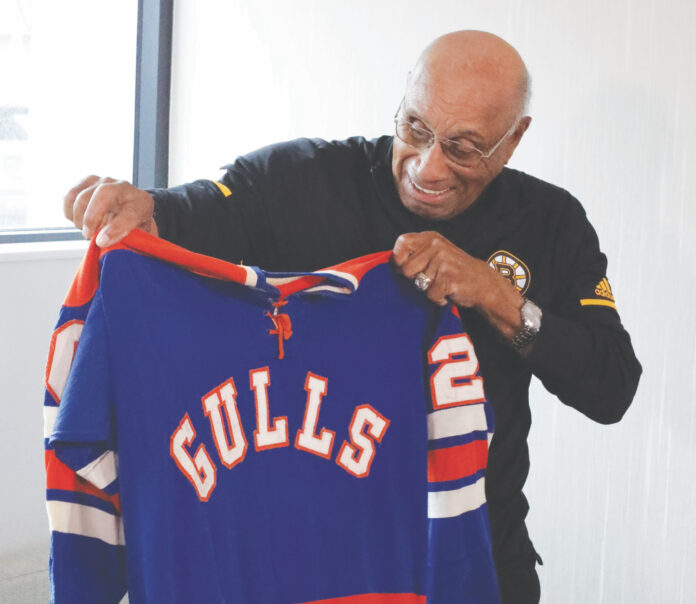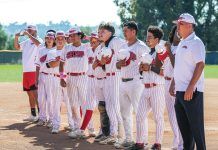
At the ripe age of 86, Willie O’Ree remains San Diego’s hockey treasure.
A member of the original San Diego Gulls of the Western Hockey League, O’Ree, a native of New Brunswick, Canada, and since longtime resident of La Mesa, skated with the legendary team for seven of its eight seasons of existence, from 1967 to 1974. The WHL Gulls were the region’s most remembered team and O’Ree was its most remembered player.
The first Black man to play in the National Hockey League, O’Ree played 21 seasons in pro hockey. He forever etched his name in the history books when he laced up his skates and took to the ice for the Boston Bruins at the legendary Montreal Forum against the resident Canadiens on Jan. 18, 1958.
O’Ree, dubbed the “Jackie Robinson of ice hockey,” played parts of two seasons with the Bruins when the NHL was comprised of just six teams situated in the northeastern United States and eastern Canada.
He incurred much verbal, and even physical abuse, in an era when segregation and segregationist attitudes dominated White-dominated society.
O’Ree appeared in just two games during his initial call-up to Boston in 1958. He would have to wait another three seasons before scoring his first NHL point. All of O’Ree’s statistical achievements were recorded during the 1960-61 season when he logged a modest four goals and 10 assists in 43 games with the Bruins.
But fate had other things in store for him as he continued playing until he was 43, finally retiring in 1979.
In seven seasons with the WHL Gulls, O’Ree recorded 153 goals and 161 assists for 314 points in 407 regular season games and tacked on 19 goals and 30 points in 40 playoff contests. He won two WHL scoring titles, scored 30 or more goals four times, and collected 328 goals, 311 assists and 639 points during his minor league WHL career.
One of the fastest skaters on the ice and one of the team’s most affable players – always willing to meet and greet with fans – O’Ree was an instant fan favorite after joining the Gulls in their second season in town after previously playing for the rival Los Angeles Blades.
For his pioneering efforts, O’Ree was elected into the Hockey Hall of Fame in November 2018 as a “builder.” He continues to serve as the league’s Diversity Ambassador, a position he has held since 1998, while working with underserved youth.
The Bruins formally retired O’Ree’s No. 22 jersey on Jan. 18 of this year.
Because of his age and the ongoing COVID-19 pandemic, O’Ree chose to participate virtually in the gala event.
It was a milestone event as his is only the 12th jersey number to be formally retired by the Bruins. He watched from a makeshift TV studio in the home of his daughter Chandra.
As he watched on a monitor as the No. 22 banner slowly rose to the rafters of TD Garden, tears streamed down his face. It was an obvious emotional moment and he said he finally couldn’t hold it back any longer.
O’Ree called it a “special moment for me and my family.”
Family members exchanged toasts at the conclusion of the event, which marked the 64th anniversary of O’Ree’s skate into history.
It was the latest in a long line of honors, some perhaps belatedly bestowed, that O’Ree has received in the past two decades. In 2008, O’Ree was presented with the Order of Canada, the highest civilian award for a Canadian citizen.
Of lasting note, United States President Joe Biden recently signed the Willie O’Ree Congressional Gold Medal act. The bill awarded O’Ree a Congressional Gold Medal, the U.S. Congress’ highest honor, for his contributions to “hockey, inclusion and recreational opportunity.” O’Ree is the first player in NHL history to receive the honor.
The current iteration of the Gulls, now playing in the American Hockey League, retired the “20” jersey number he made famous with the WHL Gulls during the team’s inaugural season in 2005-06. The banner continues to hang from the rafters in Pechanga Arena to attest to his legacy.
To Gulls fans, the color of his skin didn’t matter. What mattered most was that he was a darn good hockey player.
O’Ree’s love affair with San Diego and its fans was mutual. After his playing days were over, he remained in the region.
He now can even touch his own legacy.
Among many tributes lining up with the Bruins’ jersey number retirement on Jan. 18, O’Ree was presented with a No. 20 blue road jersey from his WHL playing days. The NHL had purchased the authenticated jersey at an auction and elected to present it to O’Ree as as special gift.
The AHL Gulls sent a camera crew out to record the event.
O’Ree was visibly touched to receive the game-worn jersey, styled from the 1968-70 seasons, and put it on for the camera. Still in fabulous shape for his age, the blue jersey still fit.
“Oh, my God, no, yeah, heh-heh,” O’Ree remarked to presenter Rob Wooley, who serves as the NHL’s senior director of legislative affairs, upon opening the box. “This is unbelievable, oh. This was wonderful and thanks to the San Diego Gulls who I had the pleasure of playing for seven years here in San Diego. It’s awesome, you know, to – I never imagined I’d be able to get the jersey that I wore when I played with the San Diego Gulls, and this just means — it just means a lot to me to be able to have it and get it framed.
“When I turned pro in 1956, I had set two goals for myself — to play pro hockey and hopefully play in the NHL. When I played my first year with the Bruins, in 1958, up against the Montreal Canadiens in Montreal, it was great. You know, I didn’t realize I broke the color barrier until I read it in the paper but it was the greatest time of my life. I believe I’ll always remember this day.
“Coming to the Gulls, I have great memories, it was wonderful. I really believe the seven years I played with the Gulls were some of the best seven years that I had played in the 21 years I played pro. I always feel that I’m a San Diego Gully. Great hockey team, great fan base, and just a great place to play hockey.”
The years haven’t dulled O’Ree’s enthusiasm for the sport or its longtime San Diego roots, which extend back to the 1940s with the San Diego Skyhawks of the Pacific Coast Hockey League. O’Ree has season tickets to AHL Gulls games, noting he once played in the AHL in 1973, to make an intimate connection.
“They’ve got my banner hanging up in the rafters, No. 20,” O’Ree said in the interview. “It’s a nice feeling, and I obviously have the great pleasure of coming and watch this team play. I enjoy watching these players display their skills and talent.”
A presentation of the event was played on the video board inside Pechanga Arena for fans during the Gulls’ inaugural Hockey Is For Everyone Night on Feb. 5.
The event sought to raise awareness to diverse groups in hockey, as well as drive positive social change and foster more inclusive communities within the sport.
Throughout the evening, the Gulls recognized five diverse groups during in-game breaks, including O’Ree; the San Diego Ducks Sled Hockey Team that consists of disabled and able-bodied athletes ages five and older, including active-duty military and veterans; San Diego Gulls Special Hockey, an athlete-centered hockey program for children and adults with developmental disabilities; the San Diego Angels, one of the top ranked girls ice hockey programs on the West Coast; and the United States National Blind Hockey Team, national athletes with a visual impairment who compete for the United States in international competition.
National team member Blake Steinecke put on an on-ice demonstration during the first intermission, showing fans how the game is played with a metal “puck” with ball-bearings so that visually impaired players can keep “track” of the “puck.” He displayed some deft moves and scored several goals to the delight of fans.
Hockey truly is for everyone — in all its forms … and colors.













